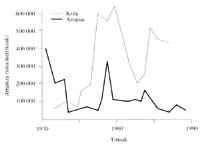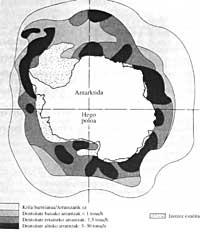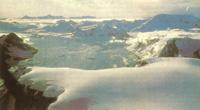The future of Kril
1990/07/01 Torrontegi, E. Iturria: Elhuyar aldizkaria
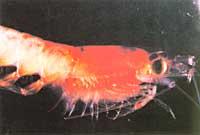
Crustaceans may not like everyone, but every year between 3 and 7 million tons are captured. It is even more surprising that the two largest crops are unknown species in the West: Akiami and Kril Antarctic paste quisquilla. Krila has reached the top of crustaceans and ranks 30th among all species caught worldwide. Although at some time a bright future was expected, why have many people discarded this species and thus extinguished that splendor?
People can have serious consequences for crime. So far, fisheries management plans have made little effort, as many consider supplies inexhaustible.
Until the 1960s, the only Antarctic species to be captured were whales and seals. When demand was reduced, interest in fish increased. In 1967 the Soviet fishing fleet began commercial fish fishing operations on the Antarctic peninsula and its islands. It was the largest amount ever captured in the South Ocean: 400,000 tons of lead. Excessive fishing occasionally causes a decrease in catches in subsequent fisheries, areas where only a few species are currently caught.
At the same time, biologists in the fishing areas observed the possibilities of exploiting these huge stocks of krils. They said the number of planking whales has decreased, so the crrila will be over. In the waters of Antarctica, data before and after the season in which the whale was captured massively indicate that the surplus was around 150 million tons.
Euphausia superba
The Antarctic Kril is one of the largest species in the world. The adult beak can reach 60 millimeters in length and weigh more than one gram. One of its most outstanding characteristics (and very attractive for fishing boats) is its presence in large banks near the surface of the water. Despite having carried out an international scientific program on the biology of Antarctic krill, many of the characteristics about the life of krill are very unknown. Biologists do not agree on the life span of crime, the time they need to grow or the productivity they have. Obviously, the lack of concrete data is an impediment to carrying out resource exploitation efforts.
But as biologists began to investigate the life of crime, there was an abundance of fishing. In the late 1970s fishing soared, reaching the peak in 1982, reaching more than 500,000 tons.
The Soviet Union is the main fishing force, Japan the second and Chile, South Korea and Poland are little fighters. In recent years fishing has dropped. The “technical problems” have been blamed, but demand is thought to be lower than supply.
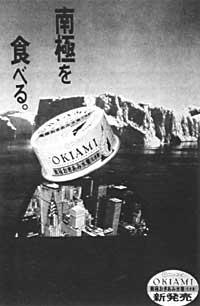
Krill fishing in the South Ocean is four times greater than the combination of all fisheries. But there are other fish, and squid, which have greater value; therefore, fishing fleets catch the quail when other species are not worth. Fishing fleets carry equipment and networks for different types of fishing. Despite the above, expensive fishing in the South Ocean and the short fishing season make the industry have to produce high value-added products to sell as food to make the most. Half of the current capture is sold in one way or another for the table. What cannot become food for humans is used as fish food.
In the industry there are other reasons to make qurila a more valuable product. Processing the rail is very complicated. It has a lot of very active autolytic enzymes that, after their death, begin to destroy the body. Krils intended for human consumption must be processed within 3 hours of capture and 10 hours for animal feed. Cracks also deteriorate immediately on the boat bridge. Therefore, it cannot be stored dry. Nor can they be stored in water, since half of the body's proteins are soluble in water.
If the beans are frozen quickly, these proteins are lost by thawing the onion. In addition, kril has high concentrations of fluorides. Most fluoride is found in the exoskeleton, which can reach four grams per kilogram. The human consumption limit allowed by the U.S. Food and Drug Administration is 100 milligrams per kilogram of fluoride. Because of its shell fluoride, the fresh kril tail contains acceptable fluoride concentrations of 5 milligrams per kilogram (unless contaminated by shell particles). But fluoride is very mobile and just killing the animal starts to get out of the shell. If you have to prepare the onion to eat, so you have to remove it immediately.
If the creature is used as animal feed, it has a problem. This food has four times more fluorides than EVD, so it should be used mixed with other foods. For pigs and birds no more than 3% krils are allowed and for farm and breeding animals is not considered safe.
The animals (fish, seal and penguins) that have qurile in their right measure have a mechanism to keep the ion out of the muscles. Fluoride accumulates in the bones and tissues have little fluoride. Crrila is also suitable for animals that grow for skins.
Fluoride problems and the need to process the grail immediately (adding also the expense of fishing in the South Ocean) alarming affect the type of product after the capture of the rail. The first commercial meal was kril-protein protein paste. This paste was curdled and normally pink, but if the plankton was made with the krill eaten, it was obtained green pasta and grass flavor. Fishing fleets tried to prevent the capture of this type of “green” kril shoals that deteriorated rapidly.
The companies of Poland and the West of Germany began to build a detailed cruise in the late 1970s. But they found it difficult to get something acceptable from a low quality hair and also, by crumbling the whole animal, their products presented a high concentration of fluorides. The chopped keel was used for sausage and zoopath, but it is not a very good raw material for the food industry (it is very alkaline) and also has difficulty mixing with water and poses problems to form emulsions with fats.
Polish manufacturers have ruled out some problems by producing a precipitate of krils by a procedure that breaks down muscle proteins and curbs them. This technique allows to separate the pulp from the shell, thus reducing the amount of fluorides of the final product. The precipitate it gives is pink and curdled, has a slight smell of crustacean and, more importantly, has good flavor. It can be a successful way to turn Kril into food.
Even so, the most valuable product is the same. In addition to the fluoride problem, in the Far East is the market of all the kril, both fresh, frozen, and then cooked and frozen. Japanese pay more for mature females, which are tasty for their high fat content. Krila is also used as food for fish farming and as fishing bait, but more than half of Japanese catches are used for the table.
Brown krils tails are used worldwide. By changing the techniques used by processors with large crustaceans, they now produce good krils tails, either to eat in vacuum or as additives in processed foods. Its krill tails are roses and its structure is elastic, with good smell and good seafood flavor. Once debarked, the kril tail is the size of a long grain of rice.
They are preserved (maintained) correctly. Once thawed, they form the jales and can emulsify other substances, which can be used with burgers, meat stews, sauce and pieces of fish. Creole is also introduced in boats and krill meat in brine (brine) is a cheap and good substitute for the quisquilla. If the kril produces a valuable and high-quality product, it can justify the high cost of capture in the South Ocean. But this approach also has its limit on the growth of the market: the entry into the market of a large number of foods similar to quisquilla could cause a drastic reduction in prices.
Fish food is a product derived from capture: for this market only this crustacean is not economic. In addition to its high fluoride concentration, krill meat has other characteristics that limit its use. It absorbs water quickly, decreasing the feed capacity of the food. Even rarer, it sometimes burns for some unknown reason.
Other krill derivatives may be more valuable than meat itself. Krils contain very active enzymes to destroy proteins. These enzymes are endopeptidases and exopeptidases and can be used for decomposition of dead wound tissues and ulcers in the medical field.
A chemical that has become attractive is chitin. The shell of krill is composed of chitin and proteins that account for 4% of the weight of the animal in dry. Krill fishing annually produces 2000-3000 tons of chitin, which normally go to garbage. Chitin is a polysaccharide polymer, with a structure similar to cellulose, which can be easily modified by creating another polymer called chitosan. Chemicals are waiting for the future of these substances.
It can play a role in the treatment of dirty water, since it curbs proteins and hijacks heavy metals. When used in bandaging wounds to reduce bleeding and accelerate healing, they are homeostatic. The pharmaceutical industry has studied the possibility of using drug capsules and surgical thread, as well as the way to reduce blood cholesterol levels.
Looking for chemicals
Chitin and kitosano polymers are biodegradable and therefore are suitable bags for storing food and agricultural chemicals. Japan currently has the Quitina Technology Implementation Council and one of the most important objectives of this Council is the development of biodegradable plastics. If chitin becomes a valuable product of krils fishing, fishing can begin to expand. If this happens, before the ecosystem comes to attack, you have to decide quickly how much krils can catch the boats.
In 1982 the Antarctic Association for the Conservation of Living Marine Resources (CCAMLR) was established. The Association based the “rational use” of living ocean resources while improving the ecosystem’s vision of resource management. From this point of view, qurila is the most important species in the Antarctic ecosystem and any object that affects krill will also affect the highest category animals in the food chain.
The association has some thorny points. First, if not all participants agree, it cannot take any action aimed at conserving the resource. Secondly, anyone can escape the obligations that a measure may require, warning within 180 days. This perspective makes it very difficult to make important decisions about the capture, since to cancel the proposal it is enough that a disgruntled voice appears.
The Antarctic Marine Living Resource Conservation Commission, also known as CCAMLR, meets once a year in Hobart, Tasmania, to discuss conservation measures from the latest research and fisheries data. Although krils fishing in the South Ocean during this decade has been the most important, the Commission has been more concerned about the situation of fish stations. Can't the Commission do anything to protect krill stakes? Data on the capture of Antarctic krill are scarce and unfinished.
The first fixed information on the movements of Soviet and Japanese fleets appeared at the meetings held between 1987 and 1988. Lack of information prevents scientists from designing a plan to organize the capture. The fact that fisheries management plans lack sufficient space on the Commission's priority list is, in the public's view, the fact that the supply of krils has no limits and that fishing is considered to be low.
In 1988 the Commission appointed a permanent working group to analyze the ecological aspects of krill related to fisheries. This group met for the first time in June last year and the most significant outcome of the meeting was to accept that krils fishing “did not have to exceed the normal level much.”
This brings the ball back to scientists: this time they must get real data. To know the amount of krill that the ocean can give, biologists must know the life time of the ocean, its productivity, its annual increase and its decrease. This does not refer to abundance, distribution and where they go and what they do in winter, for example. The construction of the most common biological model of fisheries management should also address the above issues. The alternative is to establish an arbitrary limit to the amount of fishing. This would be totally uncomfortable for the countries that fish, but if biological information is not available, it could be the only way left.
What will the future of crime be like? Three Norwegian companies have already shown their intention to start fishing in the South Ocean. The interest of private companies to capture the complaint means that there is a prospect of progress in the processing or extraction or use of chemicals. In this case, the Commission, even without data, must adopt a series of decisions for the management of fisheries and conservation of the riverbank.

Gai honi buruzko eduki gehiago
Elhuyarrek garatutako teknologia




